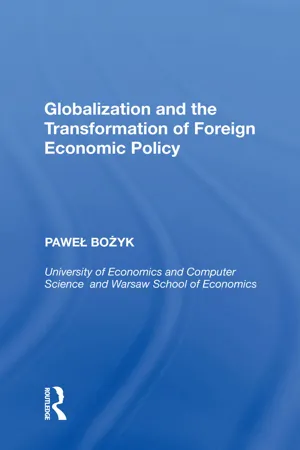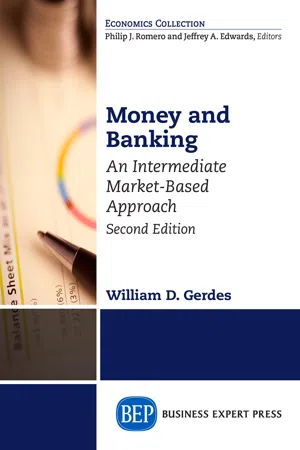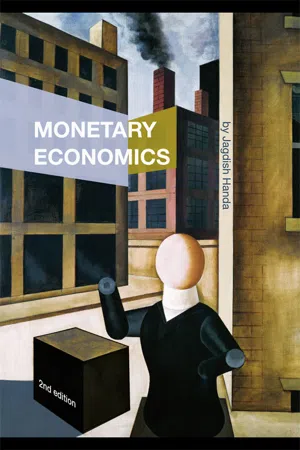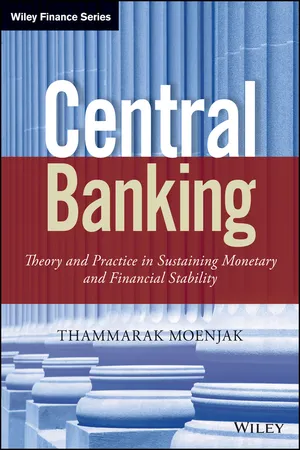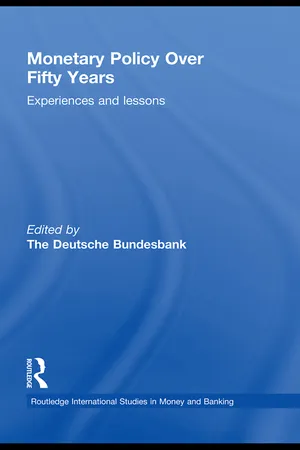Economics
Monetary Policy
Monetary policy refers to the actions taken by a country's central bank to manage the money supply and interest rates in order to achieve specific economic goals, such as controlling inflation or promoting economic growth. This is typically done through measures like adjusting interest rates, open market operations, and setting reserve requirements for banks.
Written by Perlego with AI-assistance
Related key terms
7 Key excerpts on "Monetary Policy"
- eBook - ePub
Macroeconomic Analysis and Policy
A Systematic Approach
- Joshua E Greene(Author)
- 2017(Publication Date)
- WSPC(Publisher)
Chapter 8Monetary Policy
Monetary Policy involves the use of certain policy instruments, typically interest rates, to achieve short- and intermediate targets as a way of attaining broader objectives, such as a desired rate of inflation. Figure 8.1 describes the basic framework for Monetary Policy, regardless of the particular policy regime the monetary authority uses.Beginning in the upper left-hand corner of Figure 8.1 , the monetary authority takes a policy decision and uses instruments to set an operating target — typically a very short-term interest rate, such as that in the overnight money market. The instruments involve activities such as open market operations (buying and selling government securities or its own securities to deposit money banks, sometimes through repurchase (“repo”) or reverse repurchase (“reverse repo”) operations), changing its discount rate, or changing reserve requirements. The monetary authority sets the operating target as a way of attaining an intermediate target — the growth rate of broad money, the exchange rate, or a forecast rate of inflation — in order to achieve an ultimate policy objective, such as a targeted rate of inflation. After attaining its operating target, the monetary authority reviews a broad set of indicator variables, to see how the economy has responded to its actions. Depending on the values of these variables, the authority decides whether to keep policy unchanged or make further changes to its operating target.FIGURE 8.1. BASIC FRAMEWORK FOR Monetary PolicyI. GENERAL DESCRIPTION OF THE FRAMEWORK FOR Monetary Policy
A. The Monetary Policy Objective
Monetary Policy can focus on price stability, exchange rate stability, or minimizing the variability in real output - Pawel Bozyk(Author)
- 2019(Publication Date)
- Routledge(Publisher)
Indirectly, the policy of a change ol the interest rate exerts a significant impact on the interest of foreign capital in investments in a given country. A real growth of incomes on deposits in the domestic currency encourages foreign capital to make deposits in this currency and, conversely, a decline of real incomes on deposits in the domestic currency contributes to an outflow of foreign capital. Consequently, the balance of capital turnover changes, followed by the balance of payments. A comparison of the income possible to be achieved in virtue of interest requires, however, knowledge of the predicted changes in the exchange rates of individual currencies and relations between these changes. Devaluation of a given currency (the same as its appreciation) leads to a reduction of the real income on deposits in a given currency, independent of the interest rate and. conversely, revaluation (like appreciation) leads to a growth of the real income on deposits. This is followed by an increase or a decrease of interest in holding deposits.3.4. Monetary Policy
Money is all and any means of exchange and means of payment, the ability of which to pay is unlimited both when goods or services are bought and when financial liabilities towards a creditor, a bank, central budget, local budget, and the like are settled. It performs an essential role both in the economic policy of individual countries and in their foreign economic policy.17 As a measure of value, means of circulation, means of payment and means of accumulating reserves, money facilitates the process of exchange, also including international exchange. Without money, the scale of this exchange would be much smaller and its costs much higher. Simultaneously, money facilitates the development of other forms of economic activity, including production, scientific and technical research, and the like. Without money, cooperation in production, investments, science and technology on an international scale would be impossible.In a market economy, the Monetary Policy is pursued by the central bank.18- eBook - ePub
- William D. Gerdes(Author)
- 2017(Publication Date)
- Business Expert Press(Publisher)
Keynes argued that moderating fluctuations would contribute in a significant way to improving material living standards. Moreover, he was confident that a judicious employment of government economic policies could accomplish this. On the monetary side, appropriate doses of monetary simulation and restriction where required. Stimulation was necessary when the economy lagged; monetary restriction, when an economy became overheated.While use of Monetary Policy for this purpose is symmetrical in theory, it has not been in practice. Government policies have been heavily biased toward monetary stimulation. The result has been significant monetary expansion accompanied by secular inflation.Discretionary Monetary PolicyDiscretionary Monetary Policy is most feasible in countries such as the United States, where financial markets are both relatively open and more highly developed. Central banks in these countries adjust policy instruments in response to perceived changes in the economic environment. Often those changes in policy instruments are directed toward influencing target variables that, in turn, affect ultimate policy objectives such as aggregate output or the price level. Such procedures require knowledge of the Monetary Policy transmission mechanism, which specifies linkages between the policy instruments, policy targets, and the objectives of Monetary Policy. In the United States, the Federal Reserve’s operational transmission mechanism relies upon interest rate targets.Transmission MechanismsKnowledge of the transmission mechanism is essential for implementing activist monetary policies. This mechanism indicates, usually in a sequential fashion, how changes in the instruments of Monetary Policy actually bring about changes in economic activity. Views of economists differ concerning the nature of these linkages. Behind their disagreements are different theories of this monetary process. While an extensive discussion of alternative transmission mechanisms is not undertaken, two of the more conventional ones are presented. They are outlined in Exhibit 5.1 - eBook - ePub
- Jagdish Handa(Author)
- 2008(Publication Date)
- Routledge(Publisher)
This chapter focuses on the institutional and historical aspects of the goals, instruments and targets of Monetary Policy as they have been pursued by the central banks of the United States, Britain and Canada—with some material on the newly created European System of Central Banks. This material is intended to widen the discussion beyond the particularities of any one country and to provide some indication of the similarities and varieties of central bank practices in the pursuit of Monetary Policy.Key concepts introduced in this chapter- ♦ Central banks’ mandates
- ♦ The potential multiplicity of goals of central banks
- ♦ Open market operations
- ♦ Required reserves
- ♦ Discount/bank rate
- ♦ Credit controls
- ♦ Moral suasion
- ♦ Selective controls
- ♦ Overnight loan interest rate
- ♦ Federal Funds rate
- ♦ Administered interest rates
- ♦ Currency boards
- ♦ The competitive supply of money
Economic theory has long recognized the impact of Monetary Policy upon most of the important macroeconomic variables such as output, employment, growth and prices.1 Therefore, in most countries, the control of the money supply and the manipulation of interest rates, in so far as these are possible, is entrusted to the central bank rather than left to market forces.2 This chapter looks at the basic practical and institutional aspects of the goals and targets of central bank policies, and related issues such as the regulation of financial intermediaries. Institutional arrangements and practices are specified for the Federal Reserve System of the United States, the Bank of Canada, the monetary arrangements in Britain and the European System of Central Banks, which is the federated central bank for the European Union. The intention in presenting this material on several countries is to show the common elements as well as the diversity of monetary arrangements among a group of countries.Section 11.1 examines the historically multiple goals of central banks and Section 11.2 investigates their evolution to the present goals, which are price and stability, with output at full employment. Section 11.3 reviews the instruments by which central banks conduct Monetary Policy. Sections 11.4 and 11.5 focus on the issues of competition and regulation of the financial sector and interest rates. Section 11.6 provides information on the monetary conditions index, which is used as a guide to Monetary Policy. Section 11.7 relates the evolution of goals of the central bank to the Taylor rule. Section 11.8 - eBook - ePub
Central Banking
Theory and Practice in Sustaining Monetary and Financial Stability
- Thammarak Moenjak(Author)
- 2014(Publication Date)
- Wiley(Publisher)
Fifth, expectations of households and firms could hasten the transmission of Monetary Policy to changes in output and inflation, but in a nonlinear way. If households and firms expect that the central bank is fully committed to monetary stability, even a small hike in the policy interest rate might prompt them to adjust their behavior quickly. Otherwise, the central bank might need to hike the policy interest rate many times before the public adjusts their behavior.From the outline above, we can see that changes in Monetary Policy stance take time to fully affect the economy’s output and prices. Such time lags can be quite long, and the exact timing can vary, depending on many outside factors including expectations, confidence, the stage of business cycles, etc. Empirically, studies have shown that it could take up to a year for a change in Monetary Policy to reach its peak effect on demand and output, and another year for the effect on inflation to be fully realized, although estimates vary.31The Conduct of Monetary Policy Given Time Lags and Uncertainty
Given the time lags and uncertainty involved with the transmission mechanism of Monetary Policy, the central bank needs to be quite cautious and forward-looking when considering a policy action. A change in Monetary Policy stance today will only be fully felt about one to two years later, and by that time surrounding circumstances might have already changed.32 Despite the time lags and uncertainty, however, it is still the central bank’s job to conduct Monetary Policy in such a way that stability and growth of the economy is promoted.To do its job properly, the central bank needs to understand the intricacies of and linkages within the economy. It also needs to be adept at forecasting future economic and inflation outcomes so that it can decide on an appropriate Monetary Policy action today. In practice, many modern central banks rely on a suite of macroeconomic models to forecast the future outlook for the economy and inflation. Such macroeconomic models often capture key relationships and linkages within the economy. - eBook - ePub
- Heinz Herrmann(Author)
- 2009(Publication Date)
- Routledge(Publisher)
2 , thus recognizing the primacy of price stability and its importance for achieving maximum sustainable growth.Unless it is clearly stated, however, there is a risk that the primacy of price stability as an operational objective may at times be incorrectly interpreted. Thus, to avert the risk of misinterpretation and the ensuing policy errors, it is preferable to strive for clarity in the mandate which would ensure full political support.The benefits of price stability are certainly far-reaching. That said, price stability should be the primary objective of Monetary Policy not because it is the ultimate welfare objective but because it is a necessary precondition for fostering economic prosperity. In essence, it is better to view price stability as a very convenient intermediate target–an operational objective for a central bank–a guide whose achievement is sought in order to facilitate a nation to grow and prosper over time. I make this distinction because, while I believe that we can all agree that the historical evidence supporting the importance of price stability is overwhelming, theoretical work in macroeconomics does not always lead to this conclusion without additional assumptions. And the validity of such assumptions may be hard to confirm on the basis of available evidence. For example, existing microeconomic foundations for the primacy of price stability in aggregate macroeconomic models are not thoroughly convincing. As a result, much of the literature on policy evaluation posits that price stability is one of the ultimate policy objectives to avoid implausible policy conclusions. However, the fact that we may not yet have satisfactory microfoundations for the analysis should not confuse the situation. The historical experience is too overwhelming to ignore the pitfalls of formulating policy without price stability as the dominant operational policy guide. - eBook - ePub
The Chinese Macroeconomy and Financial System
A U.S. Perspective
- Ronald M Schramm(Author)
- 2015(Publication Date)
- Routledge(Publisher)
Figure 8.2 . The LM curve shifts to the right due to the increase in the monetary base, which creates an excess supply of money in the interbank market. Interbank rates fall as a result of the excess money supply. Investment and other interest-sensitive components of demand rise as economy-wide, long-term interest rates fall. The increased demand triggers rising output and employment on the part of firms.Source: Author created.The transmissions mechanism can be represented in the standard IS/LM framework where the LM curve shifts to the right as a result of expansionary Monetary Policy and higher output and lower interest rates result.Figure 8.2Clearly, the domino-like chain of reactions triggered by Monetary Policy is complex, which explains why the great economist John Maynard Keynes doubted the effectiveness of Monetary Policy when used alone, especially during an economic downturn. As we discussed in Chapter 7 , Chinese monetary authorities have added even more tools to their toolkit for conducting Monetary Policy. So why in China are these additional tools and interventions needed, beyond the standard ones?Broad Goals of Monetary Policy
The People’s Bank of China has, as its broad Monetary Policy, this goal:Meanwhile, the Federal Reserve System has the following broad goals, as set out in a 1977 amendment to the Federal Reserve Act:Maintain the stability of the value of the currency and thereby promote economic growth (The People’s Bank of China).1Maintain maximum sustainable output and employment and stable prices (FRB of San Francisco, 2004).As we will discuss, this difference in goals helps to explain many of China’s variations in operating policy. For example, one key difference in operating policy relates to key intermediate targets. In the United States, the emphasis on the interbank market interest rate has been much greater than in China. Or for example, a U.S. long-run target of 2-percent inflation is a stated goal; but in China, maintaining the exchange rate level has been the implicit key policy target. In the next section, we present a simple theory explaining how different end policy goals lead to divergent policy paths toward achieving those goals.
Learn about this page
Index pages curate the most relevant extracts from our library of academic textbooks. They’ve been created using an in-house natural language model (NLM), each adding context and meaning to key research topics.

